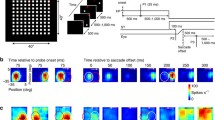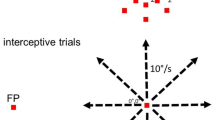Abstract
The goal of this study was to train an artificial neural network to generate accurate saccades in Listing's plane and then determine how the hidden units performed the visuomotor transformation. A three-layer neural network was successfully trained, using back-prop, to take in oculocentric retinal error vectors and three-dimensional eye orientation and to generate the correct head-centric motor error vector within Listing's plane. Analysis of the hidden layer of trained networks showed that explicit representations of desired target direction and eye orientation were not employed. Instead, the hidden-layer units consistently divided themselves into four parallel modules: a dominant “vector-propagation” class (∼50% of units) with similar visual and motor tuning but negligible position sensitivity and three classes with specific spatial relations between position, visual, and motor tuning. Surprisingly, the vector-propagation units, and only these, formed a highly precise and consistent orthogonal coordinate system aligned with Listing's plane. Selective “lesions” confirmed that the vector-propagation module provided the main drive for saccade magnitude and direction, whereas a balance between activity in the other modules was required for the correct eye-position modulation. Thus, contrary to popular expectation, error-driven learning in itself was sufficient to produce a “neural” algorithm with discrete functional modules and explicit coordinate systems, much like those observed in the real saccade generator.
Similar content being viewed by others
References
Batista AP, Buneo CA, Snyder LH, Andersen RA (1999) Reach plans in eye-centered coordinates. Science 285:257-260.
Bell AJ, Sejnowski TJ (1997) The "independent components" of natural scenes are edge filters. Vision Res. 37:3327-3338.
Bon L, Lucchetti C (1992) The dorsomedial frontal cortex of the macaca monkey: Fixation and saccade-related activity. Exp. Brain Res. 89:571-580.
Bozis A, Moschovakis AK (1998) Neural network simulations of the primate oculomotor system. III. A one-dimensional, one-directional model of the superior colliculus. Biol. Cybern. 79: 215-230.
Colby CL, Duhamel JR, Goldberg ME (1995) Oculocentric spatial representation in parietal cortex. Cereb. Cortex. 5:470-481.
Colby CL, Goldberg ME (1999) Space and attention in parietal cortex. Ann. Rev. Neurosci. 22:319-349.
Crawford JD (1994) The oculomotor neural integrator uses a behavior-related coordinate system. J. Neurosci. 69:11-23.
Crawford JD, Ceylan MZ, Klier EM, Guitton D (1999) Three-dimensional eye-head coordination during gaze saccades in the primate. J. Neurophysiol. 81:1760-1782.
Crawford JD, Guitton D (1997) Visual motor transformations required for accurate and kinematically correct saccades. J. Neurophysiol. 78:1447-1467.
Crawford JD, Henriques DYP, Vilis T (2000). Curvature of visual space under vertical eye rotation: Implications for spatial vision and visuomotor control. J. Neurosci. 20:2360-2368.
Crawford JD, Vilis T (1991) Axes of eye rotation and Listing's law during rotations of the head. J. Neurophysiol. 65: 407-423.
Crawford JD, Vilis T (1992) Symmetry of oculomotor burst neuron coordinates about Listing's plane. J. Neurophysiol. 68:432-448.
Crawford JD, Vilis T (1993) Modularity and parallel processing in the oculomotor integrator. Exp. Brain. Res. 96:443-456.
Demer JL, Miller JM, Poukens V, Vinters HV, Glasgow BJ (1995) Evidence for fibromuscular pulleys of the recti extraocular muscles. Invest. Ophthalmol. Vis. Sci. 36:1125-1136.
Draye JP, Cheron G, Libert G, Godaux E (1997) Emergence of clusters in the hidden layer of a dynamic recurrent neural network. Biol. Cybern. 76:365-374.
Duhamel J, Bremmer F, BenHamed S, Graf W (1997) Spatial invariance of visual receptive fields in parietal cortex neurons. Nature 389:845-848.
Duhamel JR, Colby CL, Goldberg ME (1992) The updating of the representation of visual space in parietal cortex by intended eye movements. Science 255:90-92.
Ernst U, Pawelzik K, Tsodyks M, Sejnowski TJ (1999) Relation between retinotopic and orientation maps in visual cortex. Neural Comput. 11:375-379.
Flanders M, Daghestani L, Berthoz A (1999) Reaching beyond reach. Exp. Brain Res. 126:19-30.
Freedman EG, Sparks DL (1997) Activity of cells in the deeper layers of the superior colliculus of Rhesus monkey: Evidence for a gaze displacement command. J. Neurophysiol. 78:1669-1690.
Freedman EG, Standford TR, Sparks DL (1996) Combined eye-head gaze shifts produced by electrical stimulation of the superior colliculus in rhesus monkeys. J. Neurophysiol. 76:927-951.
Freedman JA, Skapura DM (1991) Neural Networks: Algorithms, Applications, and Programming Techniques. Addison Wesley, Toronto.
Fuchs AF, Kaneko CRS, Scudder CA (1985) Brainstem control of saccadic eye movements. Ann. Rev. Neurosci. 8:307-337.
Georgopulos AP, Kalaska JF, Camaniti R, Massey JT (1982) On the relations between the direction of two-dimensional arm movements and cell discharge in primate motor cortex. J. Neurosci. 2:1527-1537.
Goldberg ME, Bruce CJ (1990) Primate frontal eye fields. III. Maintenance of a spatially accurate saccade signal. J. Neurophysiol. 64:489-508.
Grossberg S, Kuperstein M (1986) Neural Dynamics of Adaptive Sensory Motor Control, Ballistic Eye Movements. Elsevier North-Holland, North-Holland.
Helmchen C, Rambold H, Buttner U (1996) Saccade-related burst neurons with torsional and vertical on-directions in the interstitial nucleus of Cajal in the alert monkey. Exp. Brain. Res. 112:63-78.
Henn V, Hepp K, Vilis T (1989) Rapid eye movement generation in the primate: Physiology, pathophysiology and clinical implication. Revue Neurologique (Paris) 145:540-545.
Henriques DYP, Klier EM, Smith MA, Lowy D, Crawford JD (1998) Gaze-centered remapping of remembered visual space in an open loop-pointing task. J. Neurosci. 18:1583-1594.
Hepp K, Cabungcal JH, Duersteler M, Hess BJM, Scherberer H, Straumann D, Suzuki Y, Van Opstal AJ, Henn, V (1999) 3D structure of the reticular saccade generator in the monkey (Abstract). 29th Annual Meeting of the Society for Neuroscience, Abstract #661.6 (book 2).
Hepp K, Van Opstal AJ, Straumann D, Hess BJ, Henn V (1993) Monkey superior colliculus represents rapid eye movements in a two-dimensional motor map. J. Neurophysiol. 69:965-979.
Howard IP (1982) Human Visual Orientation. Wiley, New York.
Jürgens R, Becker W, Kornhuber HH (1981) Natural and drug induced variations of velocity and duration of human saccadic eye movements: Evidence for a control of the neural pulse generator by local feedback. Bio. Cybern. 39:87-96.
Klier EM, Crawford JD (1998) Human oculomotor system accounts for 3-D eye orientation in the visual-motor transformation for saccades. J. Neurophysiol. 80:2274-2294.
Klier EM, Wang H, Crawford JD (2000) Stimulation of the interstitial nucleus of Cajal produces torsional and vertical head rotations (Abstract). Society for Neurosci. Abstracts 25:660.18.
Krommenhoek KP, Van Opstal AJ, Gielen CC, Van Gisbergen JA (1993) Remapping of neural activity in the motor colliculus: A neural network study. Vision Res. 33:1287-1298.
Krommenhoek KP, Wiegerinck WA (1998) A neural network study of precollicular saccadic averaging. Biol. Cybern. 78:465-477.
Liu L, Sun H, Guo A (1997) Transformation of sensory signals into commands for saccadic eye movements: A neural network study. J. Theor. Biol. 189:121-131.
Moschovakis AK, Highstein SM (1994) The anatomy and physiology of primate neurons that control rapid eye movements. Ann. Rev. Neurosci. 17:465-488.
Munoz DP, Wurtz RH (1995) Saccade-related activity in monkey superior colliculus II. Spread of activity during saccades. J. Neurophysiol. 73:2234-2348.
Mushiake H, Tanatsugu Y, Tanji J (1997) Neuronal activity in the ventral part of premotor cortex during target-reach movement is modulated by direction of gaze. J. Neurophysiol. 78:567-567.
Optican LM, Miles FA (1985) Visually induced adaptive changes in primate saccadic oculomotor signals. J. Neurophysiol. 54: 940-958.
Parodi P, Jimbo Y, Kawana A, Macri D, Torre V (1998) Segmentation of the response of a neuronal network into clusters with similar activity. BioSystems. 48:171-178.
Quaia C, Aizawa H, Optican LM, Wurtz RH (1998) Reversible inactivation of monkey superior colliculus. II. Maps of saccadic deficits. J. Neurophysiol. 79:2097-2110.
Quaia C, Lefevre P, Optican LM (1999) Model of the control of saccades by superior colliculus and cerebellum. J. Neurophysiol. 82:999-1018.
Quaia C, Optican LM (1997) Model with distributed vectorial premotor bursters accounts for the component stretching of oblique saccades. J. Neurophysiol. 78:1120-1134.
Quaia C, Optican LM (1998) Commutative saccadic generator is sufficient to control a 3-D ocular plant with pulleys. J. Neurophysiol. 6:3197-3215.
Raphan T (1998) Modelling control of eye orientation in three dimensions. I. Role of muscle pulleys in determining saccadic trajectory. J. Neurophysiol. 79:2653-2667.
Robinson DA (1981) Control of eye movements. In: Brooks VB, ed. Handbook of Physiology: The Nervous System. Visual motor control. Bethesda, MD. Am. Physiol. Soc. 2:1275-1320.
Robinson DA (1992) Implications of neural networks for how we think about brain function. Behav. and Brain Sci. 15:644-655.
Rumelhart DE, Hinton GE, Williams RJ (1986) Learning internal representations by error propagation. In: Rumelhart DE, McClelland JL, eds. Parallel Distributed Processing. MIT Press, Cambridge, Mass. vol. 1, pp. 318-362.
Russo GS, Bruce CJ (1993) Effect of eye position within the orbit on electrically elicited saccadic eye movements: A comparison of the Macaque monkey's frontal and supplementary eye fields. J. Neurophysiol. 69:800-818.
Schall JD (1991) Neuronal activity related to visually guided saccadic eye movements in the supplementary motor area of rhesus monkeys. J. Neurophysiol. 66:530-558.
Scherberger H, Cabungeal JH, Heep K, Suzuki Y, Straumann D, Henn V (1998) Pre-saccadic reticular burst neuron on-directions rotate with ocular counterroll in monkeys. Society for Neuroscience Abstracts 24:60-65.
Schlag J, Schlag-Rey M (1987) Evidence for a supplementary eye field. J. Neurophysiol. 57:179-200.
Snyder LH, Batista AP, Andersen RA (1998) Change in motor plan, without a change in the spatial locus of attention, modulates activity in the posterior parietal cortex. J. Neurophysiol. 79:2814-2819.
Soechting JF, Flanders M (1989) Sensorimotor representations for pointing to targets in three-dimensional space. J. Neurophysiol. 62:582-594.
Soechting JF, Flanders M (1992) Moving in three-dimensional space: Frames of reference, vectors, and coordinate systems. Ann. Rev. Neurosci. 15:167-191.
Sparks DL (1989) The neural encoding of the location of targets for saccadic eye movements. J. Exp. Biol. 146:195-207.
Stein JF (1992) The representation of egocentric space in the posterior parietal cortex. Behav. and Brain. Sci. 15:691-700.
Tweed D, Haslwanter T, Fetter M (1998) Optimizing gaze control in three dimensions. Science 281:1363-1366.
Tweed DB, Vilis T (1990a) Geometric relations of eye position and velocity vectors during saccades. Vision Res. 30:111-127.
Tweed DB, Vilis T (1990b) The superior colliculus and spatiotemporal translation in the saccadic system. Neural Networks 3:75-86.
Van Gisbergen JA, Robinson DA, Gielen S (1981) A quantitative analysis of generation of saccadic eye movements by burst neurons. J. Neurophysiol. 3:417-442.
Van Opstal AJ, Hepp, K (1995) A novel interpretation for the collicular role in saccade generation. Biol. Cybern. 73:431-445.
Van Opstal AJ, Hepp K, Hess BJ, Straumann D, Henn V (1991) Two rather than three-dimensional representation of saccades in monkey superior colliculus. Science 252:1313-1315.
Van Opstal AJ, Hepp K, Suzuki Y, Henn V (1995). Influence of eye position on activity in monkey superior colliculus. J. Neurophysiol. 74:1593-1610.
Vilis T, Hore J (1981) Characteristics of saccadic dysmetria in monkeys during reversible lesions of medial cerebellar nuclei. J. Neurophysiol. 46:828-838.
Von Helmholtz H (1925) Treaties on Physiological Optics (vol. 3). Translated by J.P.C. Southall. Optical Society of America, Rochester, NY.
Waitzman DM, Ma TP, Optican LM, Wurtz RH (1991) Superior colliculus neurons mediate the dynamic characteristics of saccades. J. Neurophysiol. 66:1716-1737.
Woodwoth RS (1899) The accuracy of voluntary movement. Psychol. Rev. Monogr. Suppl. 3.
Xing J, Gerstein GL (1996) Networks with lateral connectivity. II. Development of neuronal grouping and corresponding receptive field changes. J. Neurophysiol. 75:200-216.
Zee DS, Optican LM, Cook JD, Robinson DA, Engel WK (1976) Slow saccades in spinocerebellar degeneration. Arch. Neurol. 33:243-251.
Zipser D, Andersen RA (1988) A back-propagation programmed network that simulates response properties of a subset of posterior parietal neurons. Nature 331:679-684.
Author information
Authors and Affiliations
Rights and permissions
About this article
Cite this article
Smith, M.A., Crawford, J.D. Self-Organizing Task Modules and Explicit Coordinate Systems in a Neural Network Model for 3-D Saccades. J Comput Neurosci 10, 127–150 (2001). https://doi.org/10.1023/A:1011264913465
Issue Date:
DOI: https://doi.org/10.1023/A:1011264913465




